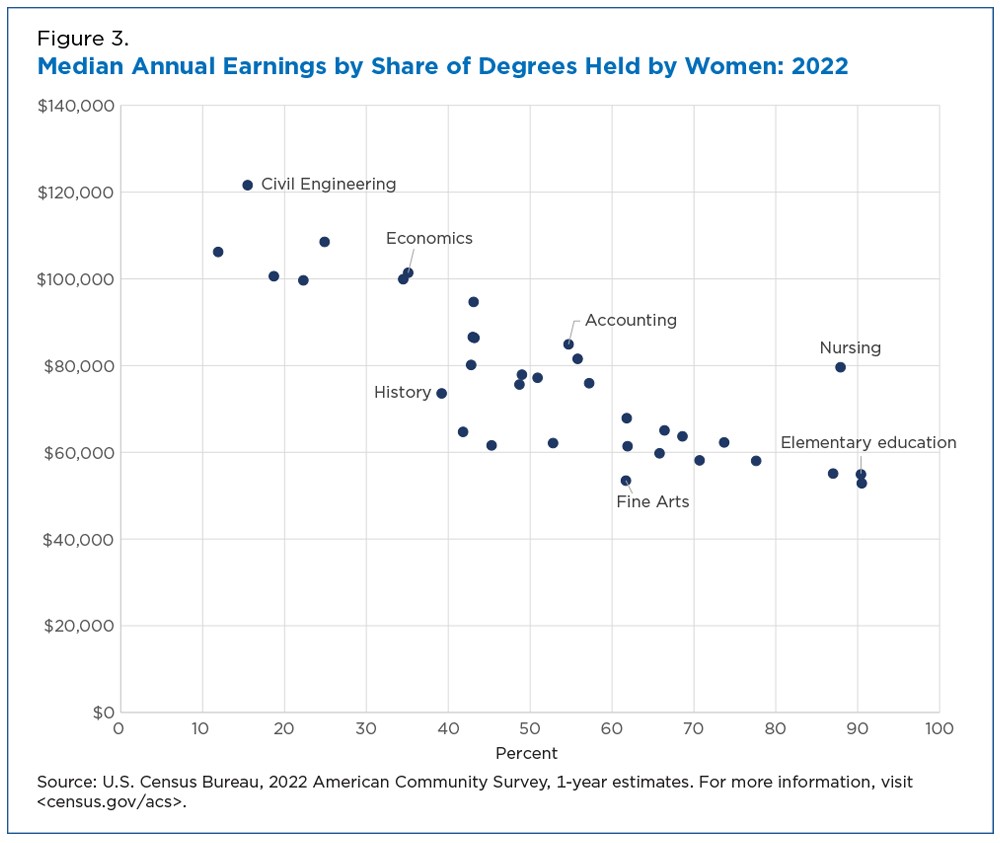Men Earned More Than Women Even When They Had Bachelor’s Degrees in the Same Field
Even among bachelor’s degree holders in the same field of study, women generally earned significantly less than men in 2022, according to new data released by the U.S. Census Bureau.
A recently released table package shows that men with a bachelor’s degree or higher earned more than women with the same education in all fields but that the difference in median earnings varied by field of degree (Figure 1).
Generally, fields of degree with a higher share (at least 60%) of women had relatively lower earnings than those with higher share (at least 60%) of men (other than nursing degree holders who earned significantly more than history degree holders).
Figure 1 shows four of the highest and lowest median annual earnings by field of degree in 2022 for men and women ages 25 to 64 with a bachelor’s degree or higher.
Men have median annual earnings of $123,800 in electrical engineering, the highest of all fields, while women’s earnings are 85.0% of men’s ($105,200). Another high earning field for women is in computer science ($91,990), but their earnings are 79.6% of men’s ($115,500).
Family and consumer sciences had among the lowest median earnings of all fields of study as well as the greatest differences by sex, with women earning $51,590, 73.2% of men’s median earning of $70,440.
In addition to differences in earnings, the composition of fields of degree also differed by sex (Figure 2).
For example, men held at least 60% of degrees in engineering (general, mechanical, electrical, civil), computer science, finance, economics and history.
Women dominated the education fields (general, elementary and other), psychology, social work, nursing, and family and consumer sciences, holding at least 70% of those degrees.
Lower Earnings in Fields of Study Dominated by Women
Generally, fields of degree with a higher share (at least 60%) of women had relatively lower earnings than those with higher share (at least 60%) of men (other than nursing degree holders who earned significantly more than history degree holders).
For example, 90.4% of people with elementary education degrees in 2022 were women and their median annual earnings of $54,900 were lower than earnings in 30 of the 33 other fields of degree (Figure 3).
Social scientists for decades have been trying to identify factors contributing to the gender wage gap, which these data show existed even among holders of bachelor’s degrees in the same field of study.
These differences in earnings may be related to differences in occupation, work experience, full-time versus part-time work and/or educational attainment beyond a bachelor’s degree. The Census Bureau plans to continue exploring this relationship in more detail.
Related Statistics
Stats for Stories
Stats for Stories
Subscribe
Our email newsletter is sent out on the day we publish a story. Get an alert directly in your inbox to read, share and blog about our newest stories.
Contact our Public Information Office for media inquiries or interviews.









